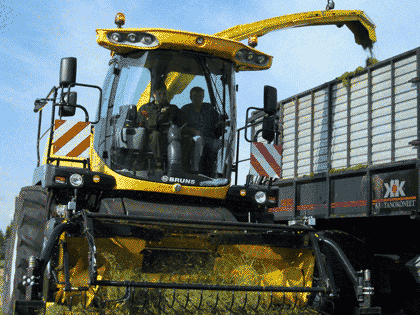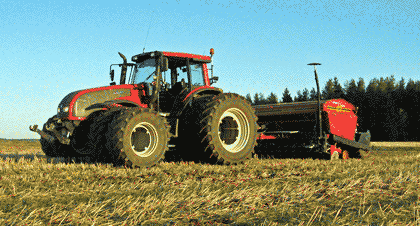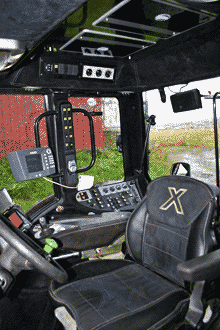Finnish contractors battle with the elements

Harsh winter weather and short daylight hours mean that the workload for Scandinavian contractors tends to be very summer-centred. Nick Fone visits one of Finland’s top operators
Imagine this: you are working in 25C heat and the sun’s beaming down almost 24 hours a day – sounds like farming paradise. But come winter you’ve got just four hours of daylight to get all your work done and the temperature’s down to -30C. That’s the reality for Scandinavian farmers and contractors.
And to battle these extremes they have to be well kitted-out – probably over-equipped by our standards.
Take the example of Kalajoen Neliveto contractors, based at Kalajoki on the Baltic coast of central Finland. The firm runs two forage harvesters – a brand-new New Holland FR9080 and an older FX40 – to chop a total 1800ha (4450acres) of grass and a further 150ha (370acres) of wholecrop cereals.

But these guys are professional operators – there’s no wastage in their system. Men and machines are worked hard for the short working window they enjoy.
Work kicks off in earnest with first-cut grass in early June and the growing season runs through to mid September. Over that time they’ve got all the grass and wholecrop to gather plus slurry tankering, combining, cultivations and drilling to get sorted.
“We’re very restricted by the short season we have, but get the benefit of extremely long days when summer does arrive,” explains Ville-Matti Vuollet. “That way we’re able to clock up about 1200 to 1500 hours a year on our tractors.”
The eight-strong tractor fleet is Finnish through-and-through. When they started out in 2000 the Vuollet brothers and their business partner Juho Isopahkala ran a mix of John Deeres and Valtras but found the green-and-yellows couldn’t match their Nordic counterparts in the harsh Finnish conditions.
Originally they had a fleet of 8000-series Valtras and in 2002 progressed on to the company’s new T-series which quickly became a firm favourite with the Neliveto operators.

Since their engine upgrade and cab revamp last year, Valtra’s top-end tractors have gone from strength to strength, according to Juha-Pekka Vuollet.
“The cab is quieter and rides far better, thanks to the semi-active cab suspension. And the addition of load-sensing hydraulics has made a big difference to our fuel use. The swash-plate pump provides oil flow as it is needed so there is no power wasted.”
Although the tractors are quieter, he does have a concern about the torque characteristics of the common-rail engines when running at low rpm.
“Torque at the bottom end of the rev range seems strangled but that’s only really a problem when you’re pulling away. Once you’re into work you can’t beat it.”
The T-series has proved such a hit with the Vuollet brothers that they look after their tractors like any good boy-racer would treat his pride and joy.
Regularly cleaned and polished, they’ve also been heavily modified both inside and out. Up in the cab there’s a digital TV screen that retracts into the roof, 400Wstereo system, heated leather seat and disco-style ultra-violet lighting. And it’s all topped off with a hand-stitched black-suede cab lining.
Outside, the tractors gain powerful Xenon worklamps and ultra-violet under-bonnet lighting. They wouldn’t look out of place on Southend seafront.
When Valtra’s men in suits got wind of the Kalajoen modifications it sparked a new marketing campaign – a limited run of 50 copy-cat metallic black T-series tractors – badged Revolution X – were produced for the Finnish market.

But it’s not just a case of style over substance, says Juha-Pekka. “When you’re sitting in a tractor for 14 hours a day you want it to be an enjoyable experience.
“It’s great being able to listen to your favourite tunes and watch a film when you’re doing boring work. Having this sort of kit means we attract and hold on to keen young drivers – they travel from all over Finland to come and work for us.”
And this is important for Finnish contractors. Because the working season extends to a maximum of six months, over winter there is no work for half of the summer gang. Most return home and find alternative work in forestry and construction.
“We’re trying to extend our winter work to keep the guys busy all year,” says Ville-Matti.
“The obvious side-line is snow-ploughing but it’s very competitive and rates are low. Really we’d be better off leaving the tractors in the shed.”
But the company has spread its wings over recent years. Earthmoving and road-building take the Kalajoki boys all over Finland and they use some pretty novel rigs to keep going when it gets cold.
In temperatures below -10C, sand, gravel and soil tends to instantly freeze to whatever it touches, so digger drivers have to be pretty quick and dump-trailers have their own heating system that channels tractor exhaust gases through the body’s box-section cross-members.
Testing and evaluation
Kalajoen Neliveto contractors are viewed as being at the top of their game in Finland and because of this equipment manufacturers use them to test and evaluate new machines.
Over the last six months the firm has had two prototype Valtra T202s on trial, one with the manufacturer’s new Versu powershift transmission, the other with its new Direct CVT.
“We drove the very first prototypes two years ago but really had a chance to test the new transmissions this summer, says Ville-Matti. “They’ve been snow-ploughing, slurry-spreading, hauling 13-20t trailers and direct-drilling with our 4m drill.”
“When you get in the cab it feels pretty much the same as the other T-series but when you start driving you realise the CVT box has transformed it into a different tractor.
“Critically Valtra has kept it simple. All our operators have been able to jump straight on, knock the shuttle lever into gear and drive off using just the pedal.”
The fact that there is a choice of four speed ranges also draws praise. “When you swap between different jobs you can ensure you’re running at a speed that makes the most of the engine’s peak torque. That way you maximise efficiency and still have plenty of room for fine-tuning within the range.”

